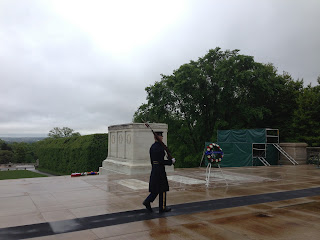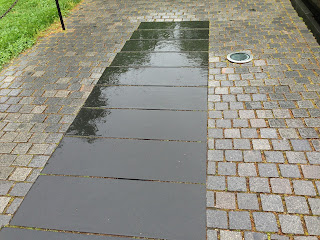Despite the rain, I really enjoyed our trip to D.C. today.
There is nothing quite like seeing what you study in person. The part of our
trip that I enjoyed the most was the Changing of the Guard at Arlington
National Cemetery. About half way through the ceremony, I realized that I
hadn’t even read the inscription on the tomb or looked at the graves below
because I was so caught up in the pageantry of it all. I think this just goes
to show that the rituals performed at memorials can be just as important, or
more important than the actual stone monuments.
It was not only interesting to see the monuments in person
because it put them in perspective, but it was also interesting to see how
other people reacted to the monuments. Comparing the Lincoln Memorial and the
Vietnam Memorial really highlights the different reactions that memorials can stir
in the viewer. In the Lincoln memorial, as Professor Kerin pointed out, people
simply stood in the main entrance gawking at the statue, chatting with each
other, taking pictures with Lincoln, or simply staying dry. Very few people
even went to look at the famous speeches in the wings or the paintings there. I
think that the meaning of these symbols and passages were completely lost on
most of the viewers, who seemed only interested in the size of the columns and
the statue of Lincoln. The Vietnam memorial, however, was very different. No one
talked loudly, or took photos of themselves with the memorial. There was a greater
sense of respect and a quieter sense awe. Visitors, grasped the purpose and the
meaning of the memorial right away, and they moved through it in the way it was
intended. Unlike the Lincoln memorial, no one missed important details because
they were hidden off to the sides. There was a very clear path to follow with
the Vietnam Memorial. The wall itself guided visitors along the right path, and
there was even a black marble sidewalk that clearly stood out from the surrounding
stone pointing the viewers in the right direction. In part I think this clearly
defined movement and direction through the Vietnam Memorial made it more
poignant than the Lincoln Memorial because there was no way to miss aspects of
the piece or mistake its purpose.
The most disappointing monument for me was the Martin Luther
King Memorial. I was hoping that it would be the most interesting, because it
is the only monument we saw today that was not tied to a war. However, I think
a lot of the power of the piece was lost in the placement of Martin Luther King
and the location of the monument in general. It would be hard to just happen
upon the Martin Luther King Memorial, unlike the other monuments we saw on the
national Mall. You would actually have to seek it out in order to find it. This
probably means that fewer people see this monument than the others. I also
thought that Martin Luther King should have been facing the other way, so that
you could see him as soon as you walked in between the split mountain. When I
first walked through I was confused by the piece because I did not realize that
you have to walk around to see the other side.





No comments:
Post a Comment